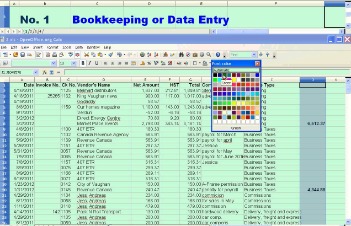Content

And, as a result of your filing status being married filing separately, you can’t claim the earned income credit or the credit for child and dependent care expenses. Your marital status impacts your filing status, tax rate, alimony payments, and more. If you are still married, you may file a joint tax return with your spouse and receive certain benefits, such as the standard deduction for married filing jointly. If your divorce has been finalized, you would file as single or, in some circumstances, as head of household.

However, the recipient spouse would then be required to include the payment as taxable income. To be eligible to file under “Married filing jointly” status, you and your spouse must be legally still married as of the last day of the tax year, December 31. To qualify for “Married filing separately” status, you must still be legally married as of the last day of the tax year. Finally, to file under “Single” status, you must be legally unmarried or legally separated as of December 31 and not eligible for “Head of Household” status. Head of Household would be defined as either a single person who provided more than half of the household maintenance costs AND whose household is the principal residence of at least one dependent. If you are married but have lived physically apart on or prior to July 1 of the tax year, you must employ “Married filing separately” status.
IRAs and employer-provided retirement plans
The next part of the publication discusses payments and transfers of property that often occur as a result of divorce and how you must treat them on your tax return. This part also explains deductions allowed for some of the costs of obtaining a divorce. In addition to increasing the child tax credit, the tax reform legislation lowered the income threshold in order to claim the credit. To qualify for the child tax credit, the minimum one family needs to earn is $2,500.
- This “pease” limitation on itemized deductions has been repealed.
- The amended order is effective retroactively for federal tax purposes.
- If you transfer property to a third party on behalf of your spouse , the transfer is treated as two transfers.
- In trial, the parties may have less control over what they receive and trial is expensive.
- Your son lived with you 180 nights during the year and lived the same number of nights with his other parent, your ex-spouse.
This meant that the IRS saw interest on a mortgage of no more than $1.1 million could be claimed at a time. This new legislation wiped this deduction for home equity debt which included existing loans beginning in 2018. If there is no new legislation in 2026, the law will go back to interest up to $1.1 million in mortgage and home equity debt as a deductible. If your ex-spouse has not applied for retirement benefits but is eligible for them, you can still receive benefits if you have been divorced for at least two continuous years. If you are eligible for retirement benefits on your own, SSA will pay that amount first, but if the benefit of your ex-spouse is higher, you will receive the difference.
Choose the Right Filing Status
Getting help from a certified public accountant or CPA to discuss your options based on these new tax rules is strongly encouraged. In other cases, those with existing agreements entered into before December 2018 may attempt to modify a current instrument based on changed circumstances. However, it’s unclear whether the change in the tax law would justify the change. This article revisits the TCJA to explore its impact on divorce and settlement agreements. We hope this will get you thinking about some essential tax considerations when planning for divorce. There may be as many scenarios about one spouse being left burdened with tax debt after the death of the other or, more commonly a divorce, as there are being-left-at-the-alter tragedies.
- If the person is your qualifying child, the child must have lived with you for more than half the part of the year he or she was alive.
- If the recipient has a job, increased withholding each paycheck could lessen the tax hit.
- If your domicile is in a community property state during any part of your tax year, you may have community income.
- If the deceased taxpayer did not have to file a return but had tax withheld, a return must be filed to get a refund.
- These income tax rates were set at a maximum rate of 39.6 percent.
You must file amended returns (Form 1040-X, Amended U.S. Individual Income Tax Return) for all tax years affected by the annulment that aren’t closed by the statute of limitations. The statute of limitations generally doesn’t end until 3 years after the date you file your original return or within 2 years after the date you pay the tax. On the amended return, you will change your filing status to single or, if you meet certain requirements, head of household.
Is Your Divorce Settlement Tax Deductible?
Your divorce decree states that the payments will end upon your former spouse’s death. You must also pay your former spouse or your former spouse’s estate $20,000 in cash each year for 10 years. The death of your spouse wouldn’t end these payments under state law. A decree or any type of court order requiring a spouse to make payments https://quick-bookkeeping.net/tax-calculator-return-refund-estimator-2020/ for the support or maintenance of the other spouse. This includes a temporary decree, an interlocutory decree, and a decree of alimony pendente lite . There are some differences between the requirements that apply to payments under instruments executed after 1984 and to payments under instruments executed before 1985.
I was referred to David Bilodeau and it was the best referral I have ever received! David talked me through every step of the divorce process and kept my head on straight from day 1 through the final day in court so I was prepared. Kidnapped childHead Publication 504 , Divorced Or Separated Individuals of household status and, Kidnapped child. TAS can provide a variety of information for tax professionals, including tax law updates and guidance, TAS programs, and ways to let TAS know about systemic problems you’ve seen in your practice.
Splitting Tax Refunds
This is because the amount of after-tax income is directly proportional to the amount of revenue the government receives; the more after-tax income that tax payers receive, the less money the government takes. Despite the increase in after-tax income, however, the places that money flows from have undergone some changes. That alimony and other support payments can no longer be deducted by the payor might make the increased standard deduction a more reasonable choice than itemized deductions. This is unfortunate if the support payments are more than $12,200.

There is a federal tax credit for people who are permanently and totally disabled. For more information, see IRS publication 524, Credit for the Elderly or the Disabled. Generally, you must report as income any amount you receive for your disability through an accident or health insurance plan paid for by your employer. If both you and your employer pay for the plan, only the amount you receive for your disability that is due to your employer’s payments is reported as income. Your employer should be able to give you specific details about your pension plan and tell you the amount you paid for your disability pension.


